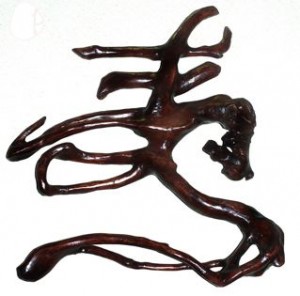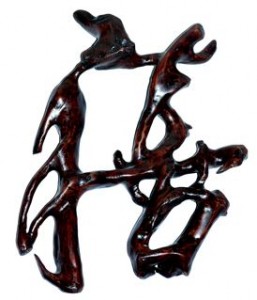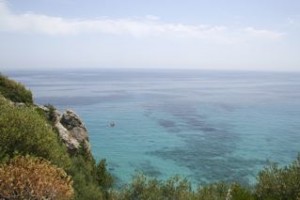
In the first blog post in this two-part series, we mentioned that Dr. Michel Poulain, a Belgian demographer researching longevity, along with Dr. Gianni Pes, a medical statistician tied to the University of Sassari, Italy, coined the name Blue Zone.
Why choose the name Blue Zone you ask?
It is reported that the two researchers were zeroing in on villages in Sardinia’s Nuoro province with higher concentrations of long lived males. Using blue ink, they drew concentric circles on a map and afterwards referred to the geographic area within those simply as the Blue Zone.
(Image of Chinese character for longevity crafted from azalea root courtesy of assiewin at rgbstock.com)
Later, it turned out that an adventurer by the name of Dan Buettner became interested in their research efforts.
Apparently previously Buettner had done some work with National Public Radio which made him aware of just how valuable publicity could be, so he had made some life choices to combine his adventurous spirit with publicity opportunities. Buettner had pursued & attained world distance cycling records which afforded him the publicity he considered key to future media success. He became known for cycling, exploring, and sharing his adventures in an educational context with others via various media. Buettner clearly appreciated the value of a story-telling approach to enhance learning.
Those cycling trips wound up piquing his interest in demographics & longevity, and in turn his desire to learn first hand more about other hot spots of longevity besides the Nuoro province of Sardinia. He clearly recognized the vast potential for publicity of the longevity research work of scientists such as Poulain & Pes, including possible spinoff business ventures of his own. Buettner teamed up with various scientific researchers and sought out team effort opportunities. National Geographic helped fund Buettner’s trekking around the globe for over a decade.
As mentioned in Part 1 of this series, research teams eventually focused on 5 global locations that were each labeled as a Blue Zone longevity hot spot: Loma Linda, USA; the Nicoya Peninsula, Costa Rica; Ikaria, Greece; Sardinia’s mountainous region, Italy; and Okinawa, Japan.
Although research scientists with advanced degrees are usually passionate about their work, they don’t necessarily find it easy to step into the roles of spokespersons promoting it. Buettner, on the other hand, was very familiar & comfortable with publicity and saw an opportunity and became a public face for promoting the idea of Blue Zones. He even started a business using the name Blue Zones®. His book, The Blue Zones: Lessons for Living Longer From the People Who’ve Lived the Longest, was released through National Geographic Books in 2008.
By 2009, Buettner’s Blue Zones® company had teamed up with the United Health Foundation and the American Association of Retired Persons (AARP) with the idea of engaging members of an entire community within an industrialized nation to see if they could embrace some of the traits noted in the Blue Zone longevity research.
That AARP/Blue Zones Vitality Project was counting on attracting media attention/publicity (Buettner’s forté) to what health educators and health professionals have suggested to consumers/clients/patients for decades–incorporate small changes in lifestyle and environment to make a positive difference in lives.
In 14MAY2009 the City of Albert Lea, MN, became committed to the AARP/Blue Zones Vitality Project, reportedly receiving 10K each from the United Health Foundation and AARP. The Albert Lea Medical Center contributed another 27K towards the effort.
Two epidemiology professors from the University of Minnesota School of Public Health directed the pilot phase of the Vitality Project: Leslie Lytle; along with Jean Forster, who worked to change the environment to discourage smoking. There was also additional guest expert input from Brian Wansink and Dan Burden over time in that community.
Members of the City of Albert Lea who signed up for the project were encouraged to:
- get involved in exercise and movement as part of the activities of their daily lives;
- eat more wisely focusing on key plant based principles, likely adapting some version of eating akin to a Mediterranean style dietary approach incorporating consumption of a wide variety of food items such as cooked pulses/legumes/beans, whole grains, vegetables, fruits, some dairy and some meat, utilizing preparation styles that might include a little olive oil or other desirable oil;
- form groups composed of members of the project with common interests such as walking (similar to the moai support groups of lifelong friends noted on the island of Okinawa); and
- embrace a positive outlook on living.
The active pilot phase of the AARP/Blue Zones Vitality Project lasted for 6 weeks from 8SEP2009 – 16OCT2009.
Heartened by the initial buy-in of numerous residents of Albert Lea into the mindset of the pilot Vitality Project, the City of Albert Lea extended its commitment to the effort. Over a 3 year period of time, the ongoing momentum and positive changes in the environment of the city have been noted. When June 2012 rolled around, a visible symbol of that success was a completed 5 mile walking, jogging and bike route around Fountain Lake.
We mention this because as noted in our Part 1 blog post, except for the large Seventh Day Adventist population in Loma Linda, which is located in an industrialized society, the other populations of Blue Zone elders have traditionally embraced a more agrarian lifestyle.
Bringing publicity about what health educators and health professionals have told individuals for years into the public eye in a city such as Albert Lea meant more people sat up and took notice.
We’ve already mentioned in our Part 1 blog post some common factors thought to be associated with the longest lived Blue Zones elders experiencing active lives (exercise, simple approaches to shedding stress, plant-based dietary habits, growing & preparing food in home settings or locally, living lives with a mindset based on never having to retire per se).
There are a number of other factors the researchers found that the longest living people had in common, some of which were focused on in the pilot Vitality Project in Albert Lea.
Realize that with all of the factors potentially involved in longevity, not all locations will have all of the factors in common, but all locations will have some of the factors in common.
As Michel Poulain noted in a 2009 Dateline NBC piece “There is really 1000 way to reach 100” and his research partner, Gianni Pes added “What is important is not only to live longer, but to live in good health status.”
As a scientist, Poulain is well aware of the intricacies of interaction between genetics and epigenetic influences each of us is exposed to over a lifetime.
By his statement, Poulain was acknowledging the many variables involved in our lives and the multitude of choices we actually make over the course of a lifetime. Stacking the deck for more positive interactions means we can potentially live a longer period of time enjoying more wellness than illness as Pes mentioned.
Even though we can’t control our genetics, we can to an extent control many life choices. No guarantees that will mean we will live a longer, healthier life, but it does up the odds a bit.
(Image from Sardinia courtesy of micromoth at rgbstock.com)
Five Other Common Factors Found in Blue Zones
6. Blue Zone elders seemed to grasp the idea that meals should be enjoyed and not rushed–that meals should be eaten with more of a sense of appreciation and enjoyment. As a result, they realized when eating that their hunger was being addressed and they could stop themselves from pushing the limits of eating and chose to stop eating when they felt mostly full–it is estimated to be ~80% full, not missing the last 20% they could have eaten, but didn’t eat. This awareness of eating reminds one of the principles that have been promoted through various coined terms in our industrialized societies in an effort to get “back to basics” including terms such as Mindful Eating or Intuitive Eating, etc. Blue Zone elders have historically eaten more heartily during the earlier part of the day and by late afternoon or early evening had their smallest meal and then called it quits for the rest of the day.
7. Except for the Seventh Day Adventists, the other elders in the Blue Zones reportedly drank some form of alcohol or wine beverage (equivalent 1-2 glasses daily) on a regular basis, still embracing the idea of moderation in their lifestyle. They didn’t binge on food or drink–they simply lived each day for its own merits. Their dietary patterns have tended to be high in anti-oxidant and anti-inflammatory substances. The Sardinians and Ikarians have embraced some version of a Mediterranean style diet.
8. Family units tended to be stronger and long-lived elders always put family first. Partners stayed together, and family cared for elders and for children (the equivalent of the sandwich generation in the US, except the support system within the Blue Zone community was much greater and others helped deal with some of the burdens and thus relieved some of the stress).
9. Communities tended to be stronger and positive health behaviors and attitudes wound up being contagious within the social network. Those familiar with marketing celebrity Seth Godin and others like him are familiar with the word “tribes” being used to describe these social circles.
10. A sense of purpose for living has been very strong among the elders. Whether it has been faith-linked or not didn’t seem to matter, and embracing any belief system has seemed sufficient. The whole idea of getting up and living each day in a meaningful way driven by this sense of purpose in Blue Zones has existed in sharp contrast to how many persons in industrialized societies may appear to live. Psychologists in industrialized societies today are often working with numerous individuals who feel they merely exist without having any greater sense of why they are alive and how they can make a positive difference through their living.
If you’re interested in delving further into the core concepts associated with longevity as studied in any of the Blue Zone locations and looking for ways to possibly incorporate some of those concepts into your own life, there are many ways to do so. Various health education materials exist in abundance from both public and private sources. When it comes to matters of positive dietary patterns and exercise, even the US government has gotten behind the idea of My Plate as well as Let’s Move! You can also check out the BlueZones Study Guide.
Just remember that there’s still time to change your health behaviors this year and embrace new habits if you really want to. If you desire professional assistance, be sure to seek out truly qualified professionals as there are many health care professionals willing and able to coach you in making the changes you want to embrace. Be aware that health coaching, however, is not a regulated profession the way health care professions are regulated, so chose wisely if you do decide to involve some type of health coaching in your behavior change efforts.
 We’ll do a follow-up blog post focusing on what researchers found when they went elsewhere to learn more about common lifestyle elements associated with happiness.
We’ll do a follow-up blog post focusing on what researchers found when they went elsewhere to learn more about common lifestyle elements associated with happiness.
They traveled to Denmark, Mexico, San Luis Obispo (in California, USA), and Singapore. Look for that blog post next week.
(Image of Chinese character for happiness crafted from azalea root courtesy of assiewin at rgbstock.com)
As always, the above content is offered for infotainment purposes only, as is all content on this site. We urge you to discuss any health related concerns you or your family members may have with those health care practitioner(s) who are credentialed along with being certified/licensed to practice in your location. Being under their care gives you the opportunity to discuss specifics unique to your own and/or your family’s health situation accordingly.


